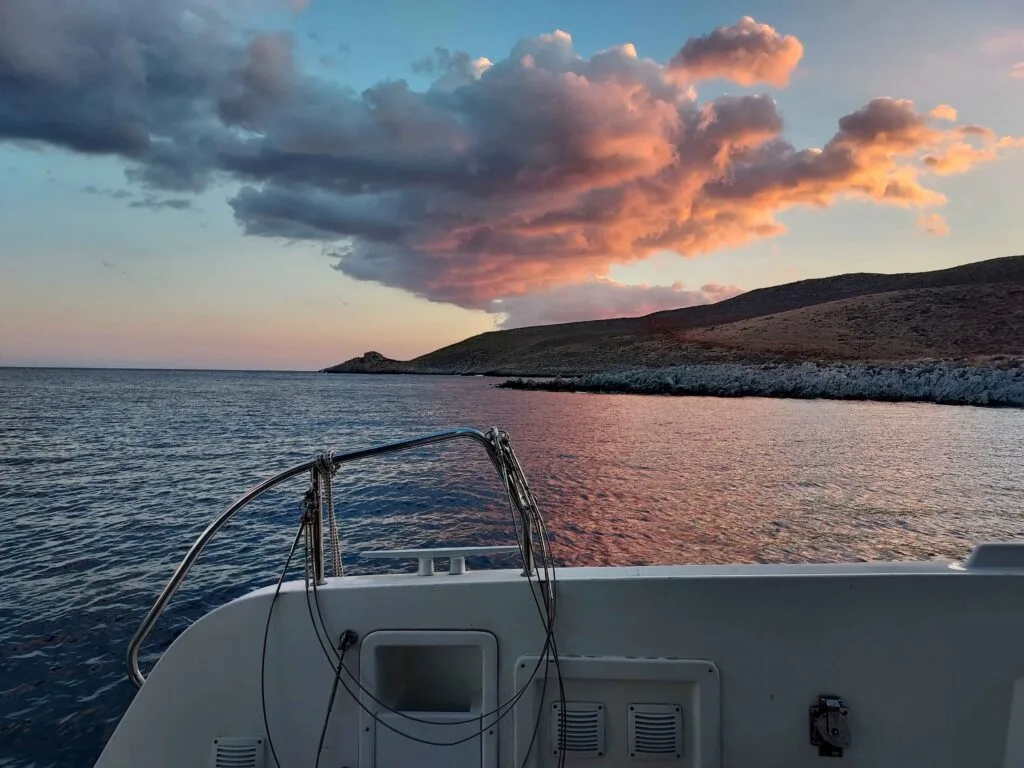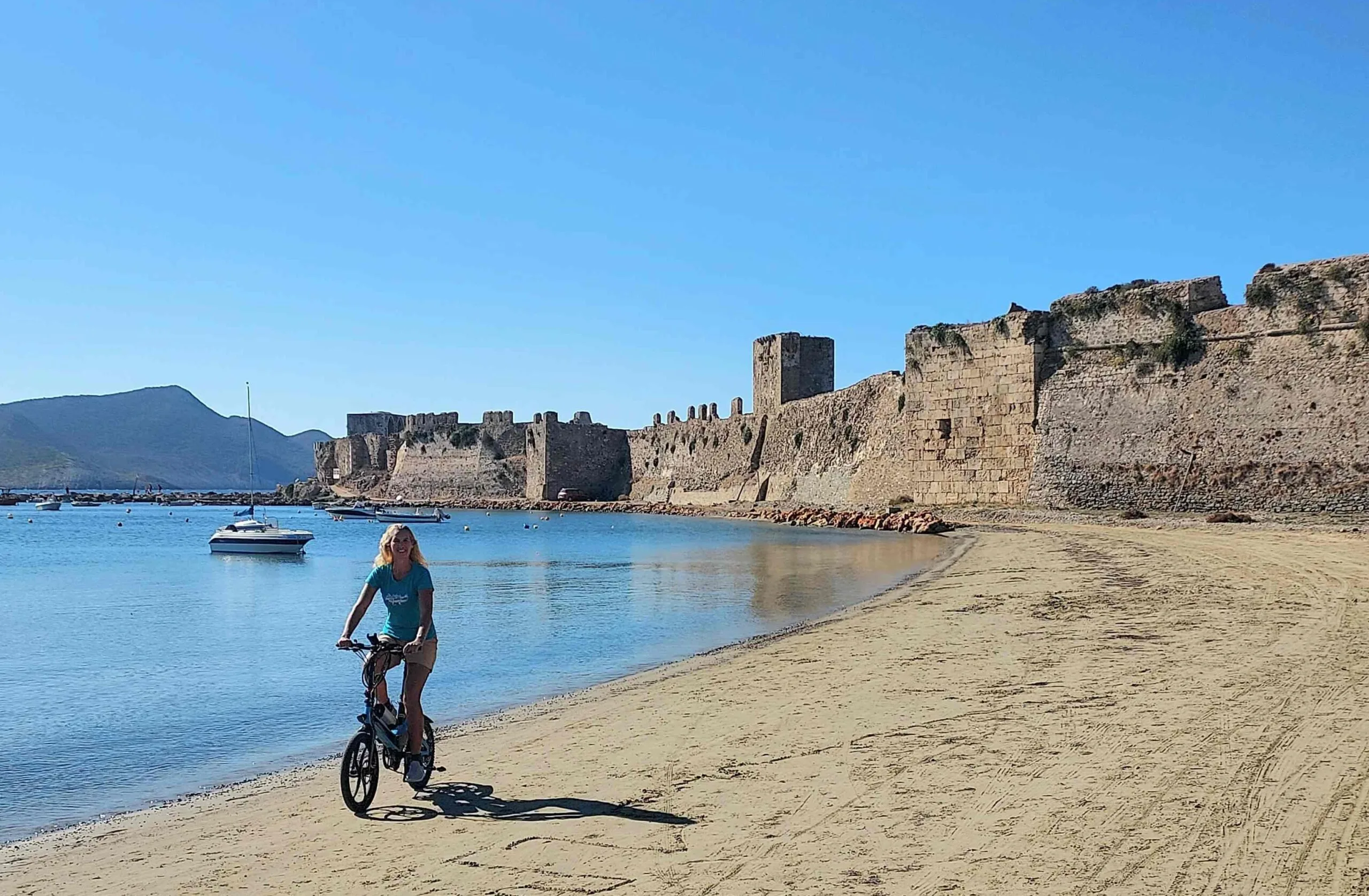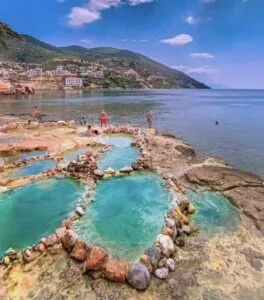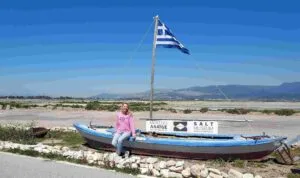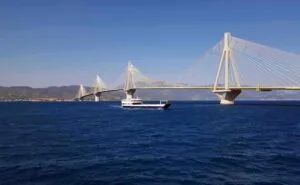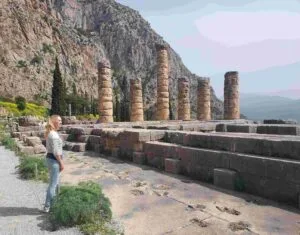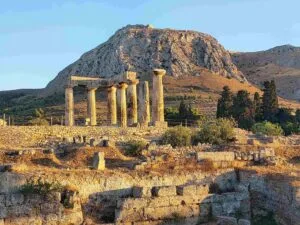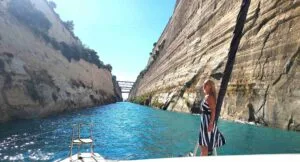In this time of year only a few boats are seen sailing here in Greece. But we love Wintersailing! Especially here in the south of Greece there are many sunny days. You just have to plan your saildays a little bit better, because the winds can be strong and harbors can be closed or have no electricity available.
In blog nr 171, we let you know that we are now on the southernmost part of the Greek mainland: the peninsula Peloponnese.
We described how we started on the westside of Peloponnese which had quite wild nature and then sailed to the lovely the village of Katakolo with a small fishing port:
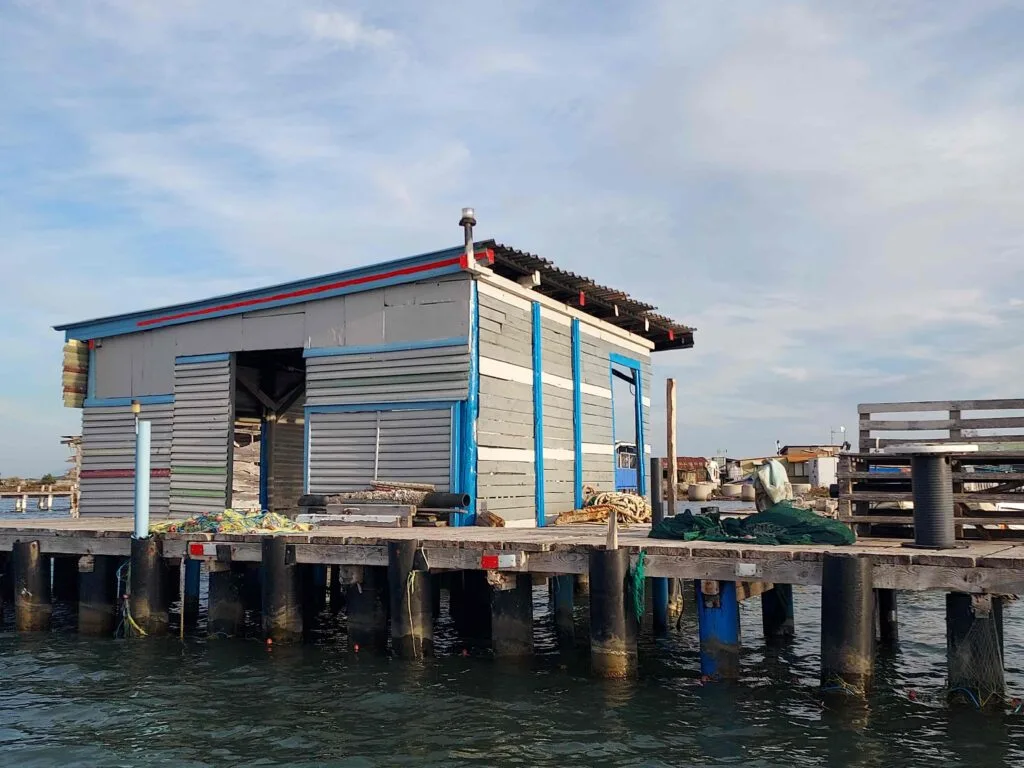
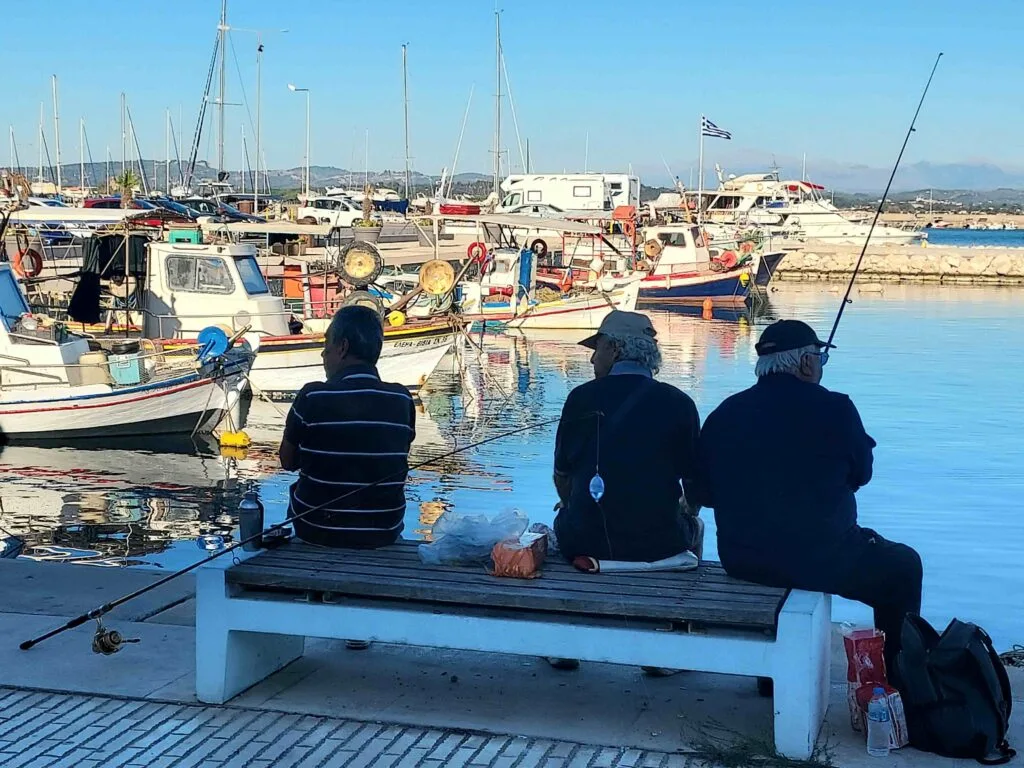
The blog was mainly about the impressive ancient city of Olympia. Really impressive to spend a day there.
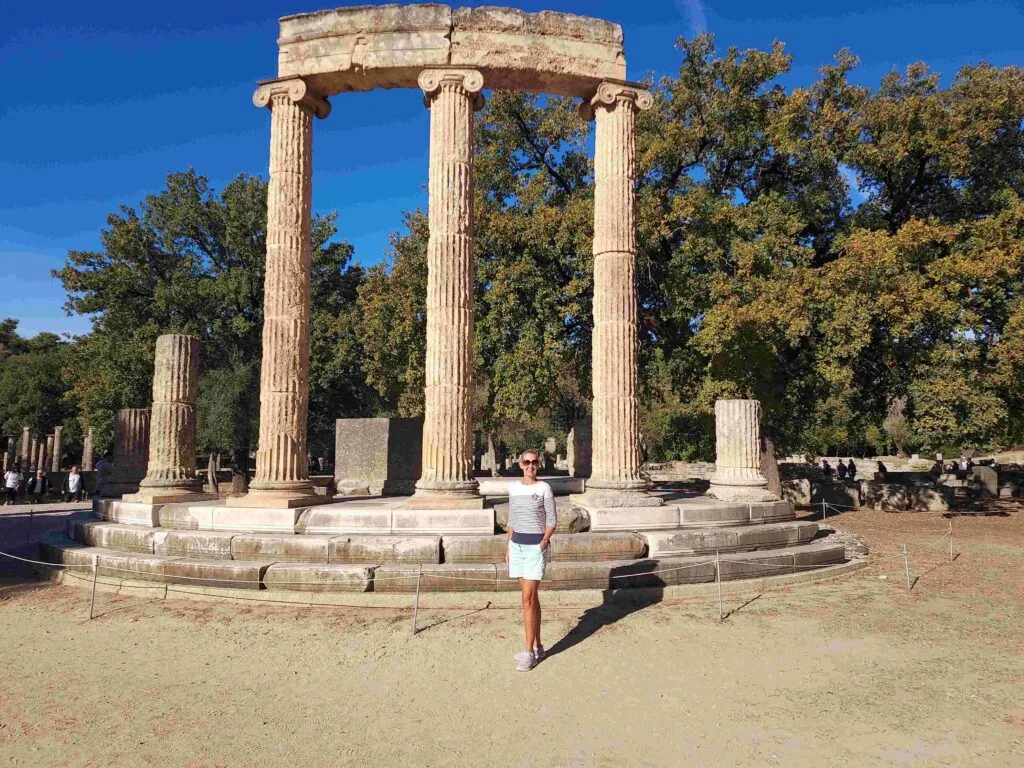
Now, we would like to show what other interesting places we visited on the westcoast and southcoast of Peloponnese.
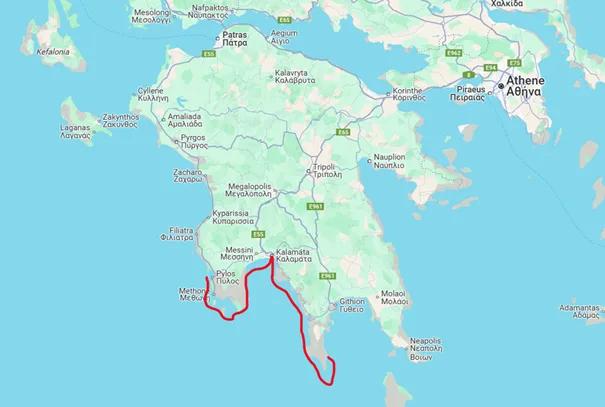
Pylos
We had a long day of sailing ahead after we left Olympia. I like making lunch during the sailing trip and like my father always said: “keep life simple”, so eating hot small sausages, with toast and some mustard while I look out over the sea, I really enjoy it!
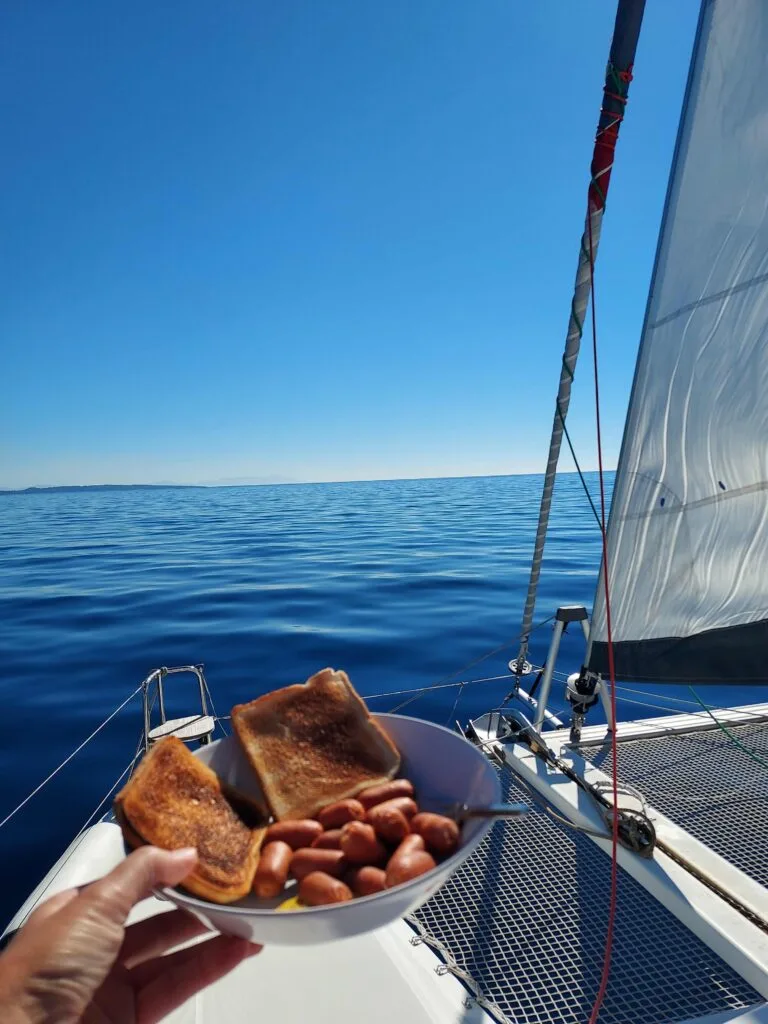
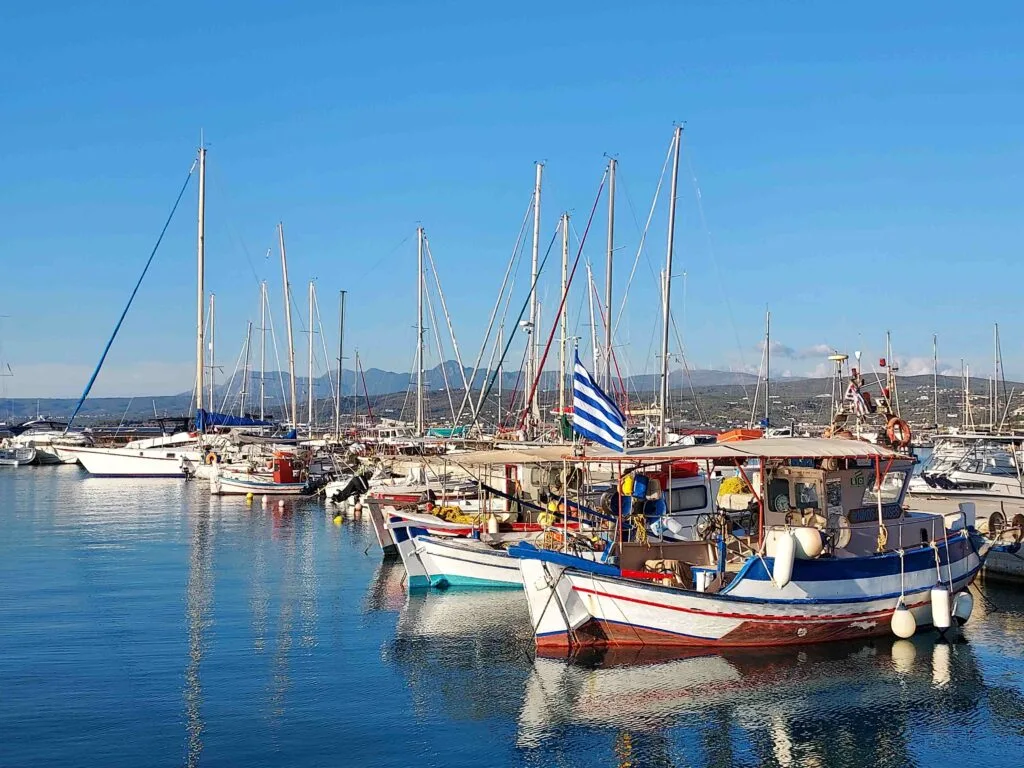
The harbor of Pylos were we ended up after sailing is really picturesque.
Pylos is located on the Navarino Bay with a long island in front of it. Because we are on the west side here and it was a very sunny day, you get this fantastic sunset.
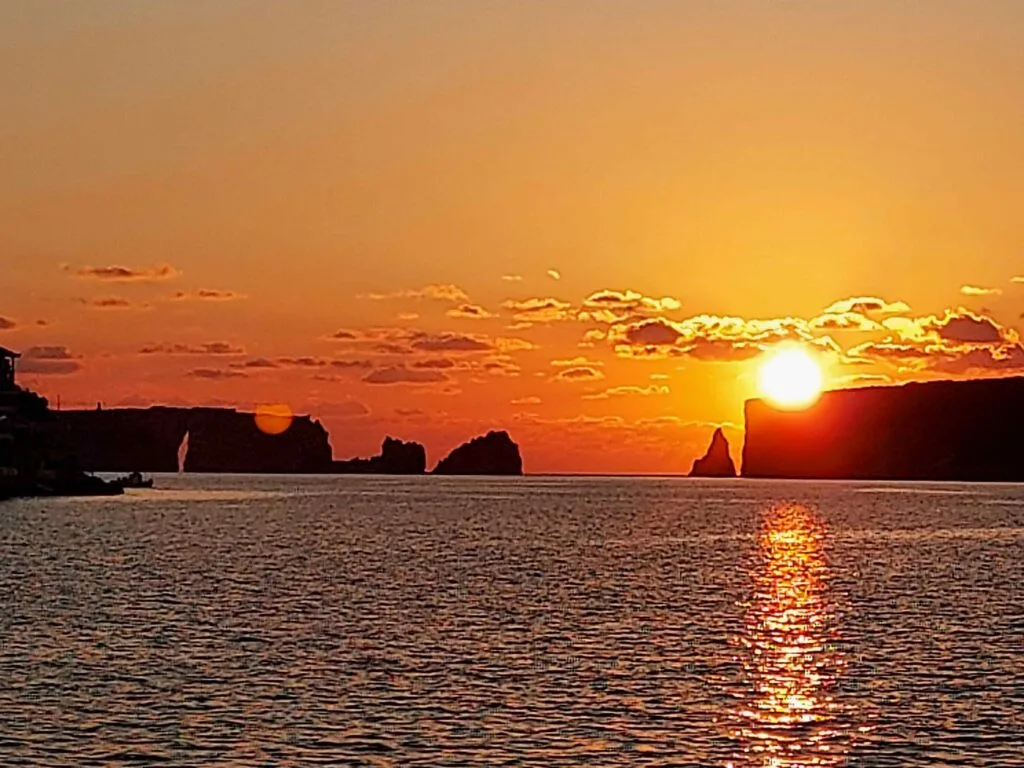
During a walk on the edge of town I noticed how much nature and greenery there is here.
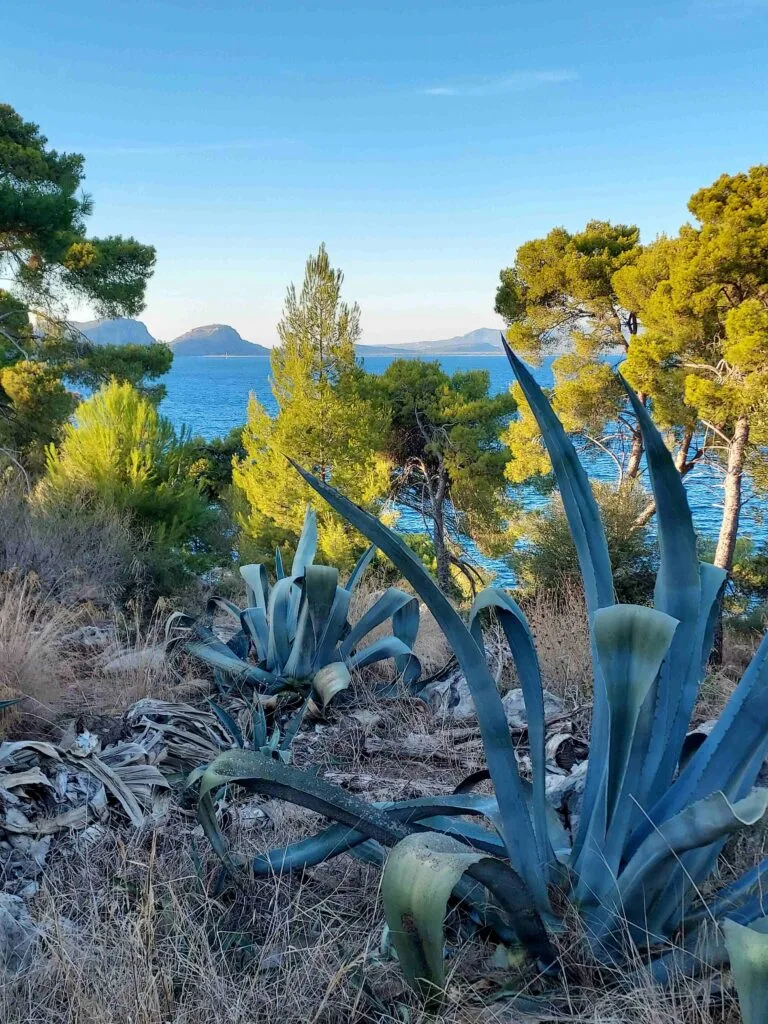
I also noticed that there are miniature churches sometimes on the side of the road. Even when we go cycling and have to take a bit of highway, you see these churches. They are called ‘ikonostasia’. These icon houses often have a religious and commemorative function. They are often placed as a memorial for someone who died at that location, for example in a car accident. They serve as a tribute and memory of the deceased. They usually contain an icon of a saint, a photo of the deceased, an oil lamp, and sometimes personal items.
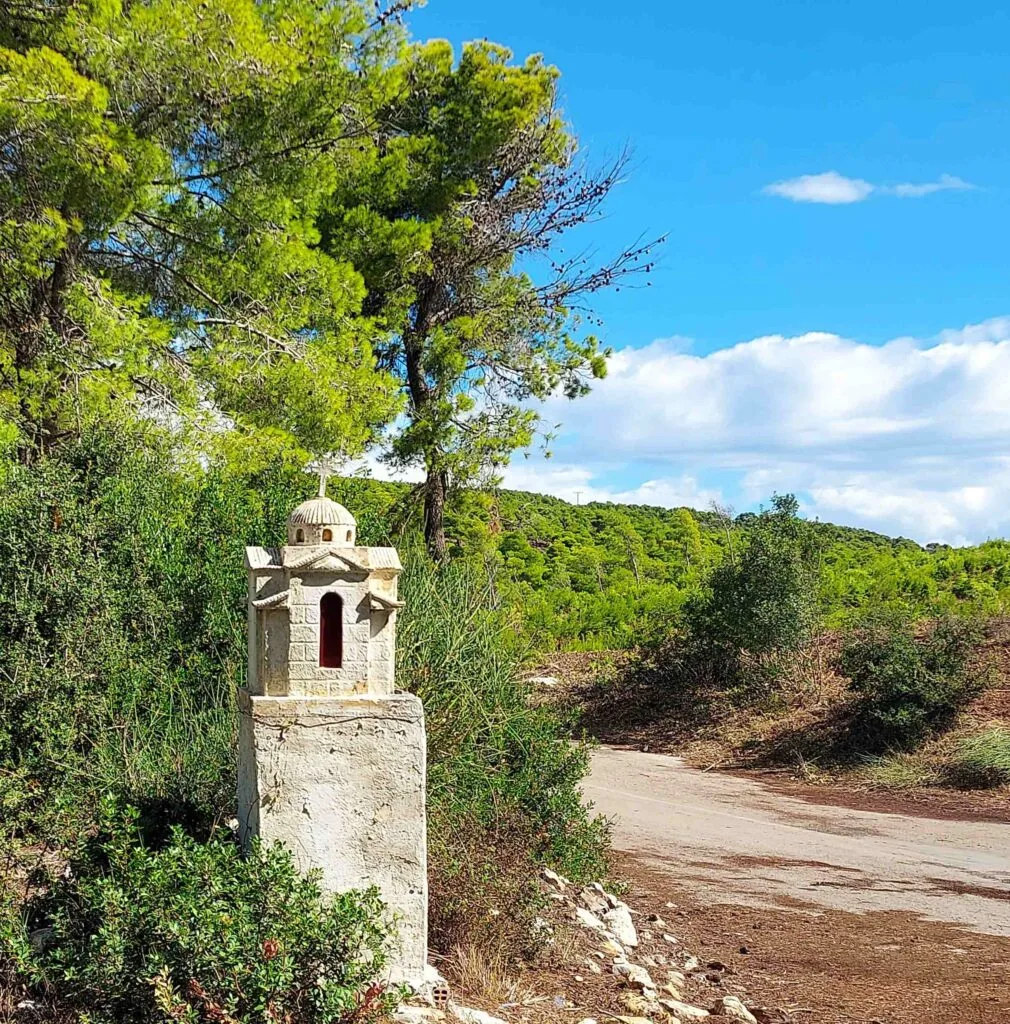
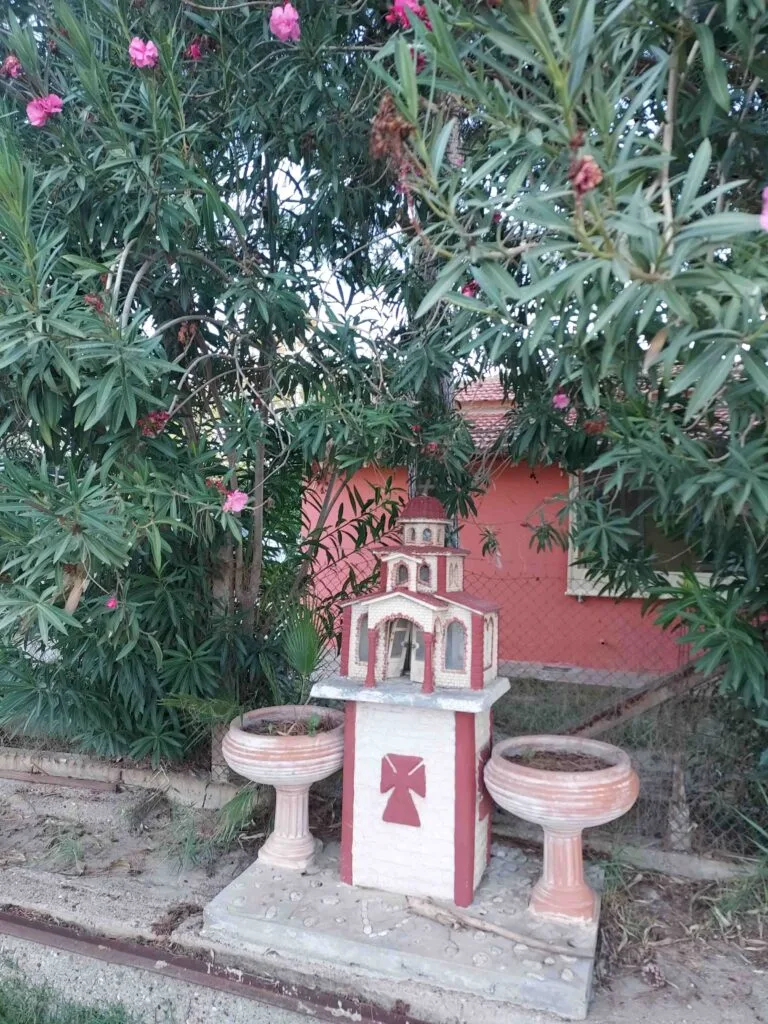
Some churches are not built as a memorial, but out of gratitude. For example, if someone has survived a serious accident. In that case it is a kind of offering or gesture of thanks to God or a certain saint. The churches reflect the strong Orthodox Christian tradition in Greece. Many Greeks believe that prayer and burning an oil lamp offers protection to travelers and the soul of the deceased.
Pylos also houses a castle built by the Ottomans in 1573.
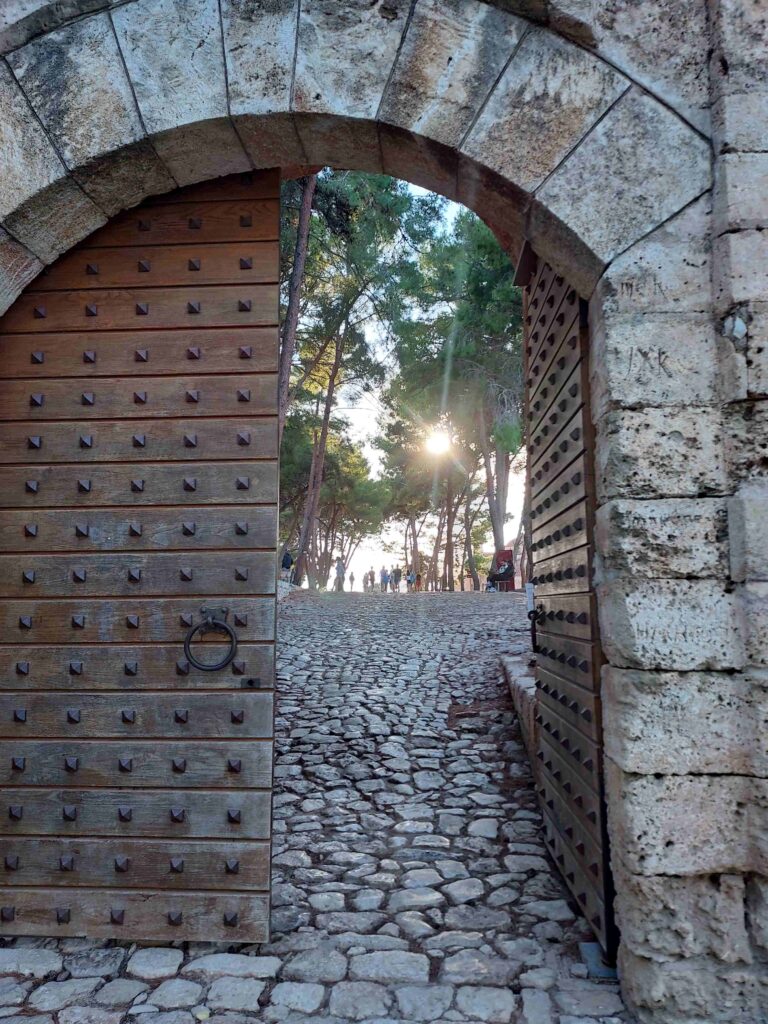
During our trip we not only do sightseeing, but we also regularly go shopping or buy things for the boat. In this case we needed paint and on the way with the scooter and the e-bike we found this paint shop. Incidentally, the Greeks often proudly fly their flag. Especially at shops and churches you often see the white-blue flag.
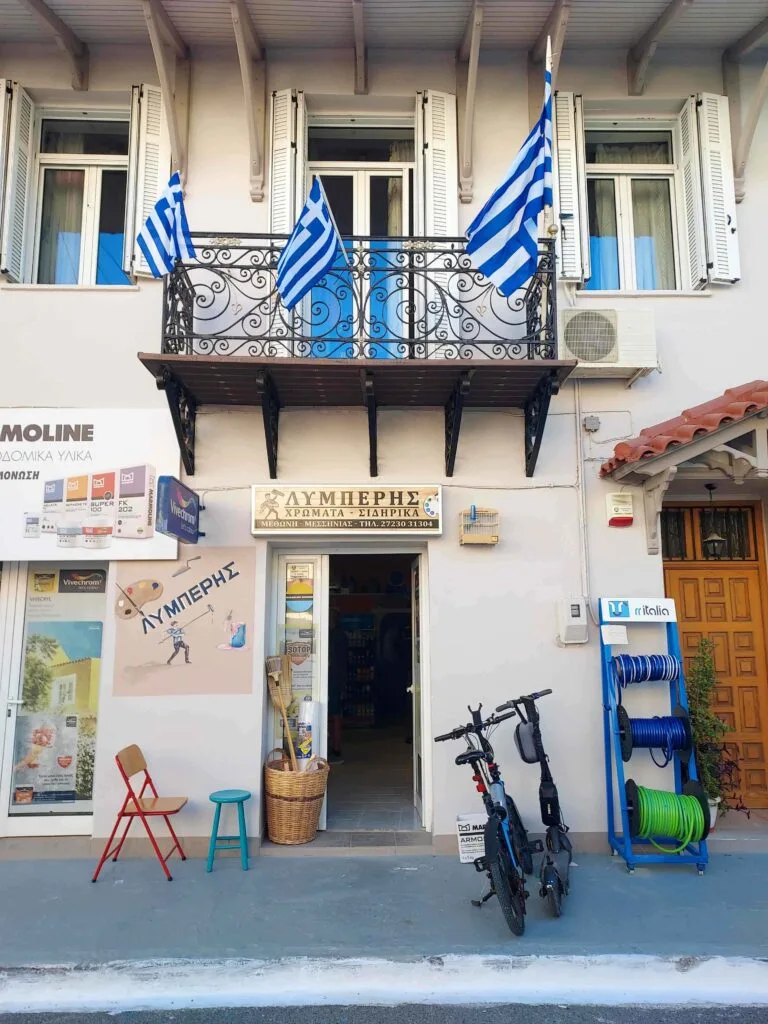
It also reminded me of the fact that in the Netherlands you hardly see Dutch flags hanging outside on ‘normal’ days. It was also funny that the harbor master asked: are you from the Netherlands or Holland and what is the difference? We get this question so often. So I thought, I’ll also post this on LinkedIn: what do you answer when people ask where you are from today: the Netherlands or Holland? Well, that caused a lot of commotion! Almost 20,000 people saw the message and 55 answers. It was 50/50 😉.
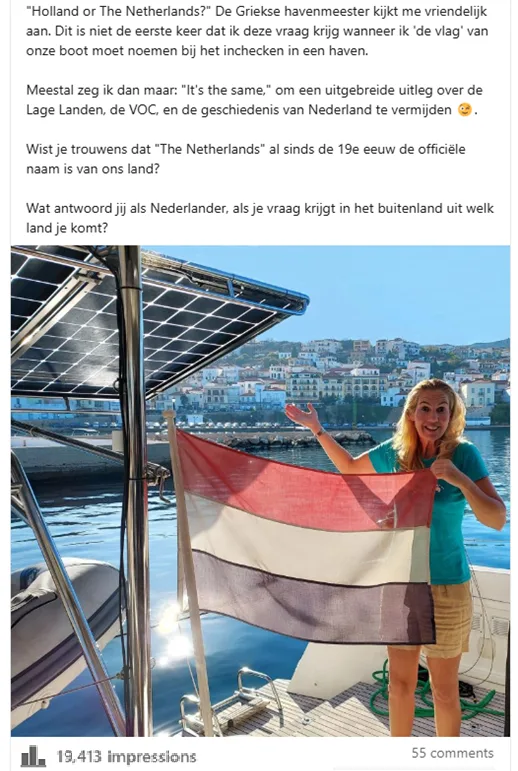
Methoni
We cycled from Pylos to Methoni, which is 12 kilometres south of Pylos.I had read that the castle of Methoni was one of the most impressive and well-preserved medieval castles in Greece. It turned out to be quite a large structure, right on the beach. So to get there, you really had to walk or cycle along the beach.
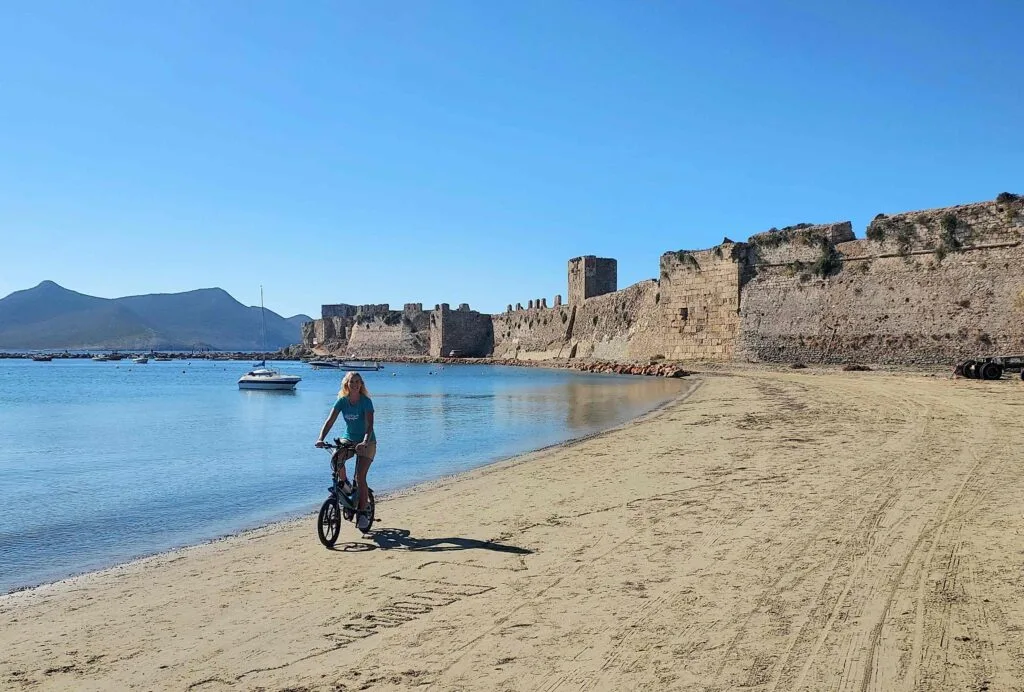
The castle was built and expanded by the Venetians in the 13th century, after the Fourth Crusade (1204). It served as an important port and trading post in the Mediterranean. Methoni was called the “Eyes of Venice” because it oversaw the sea connections with the East.

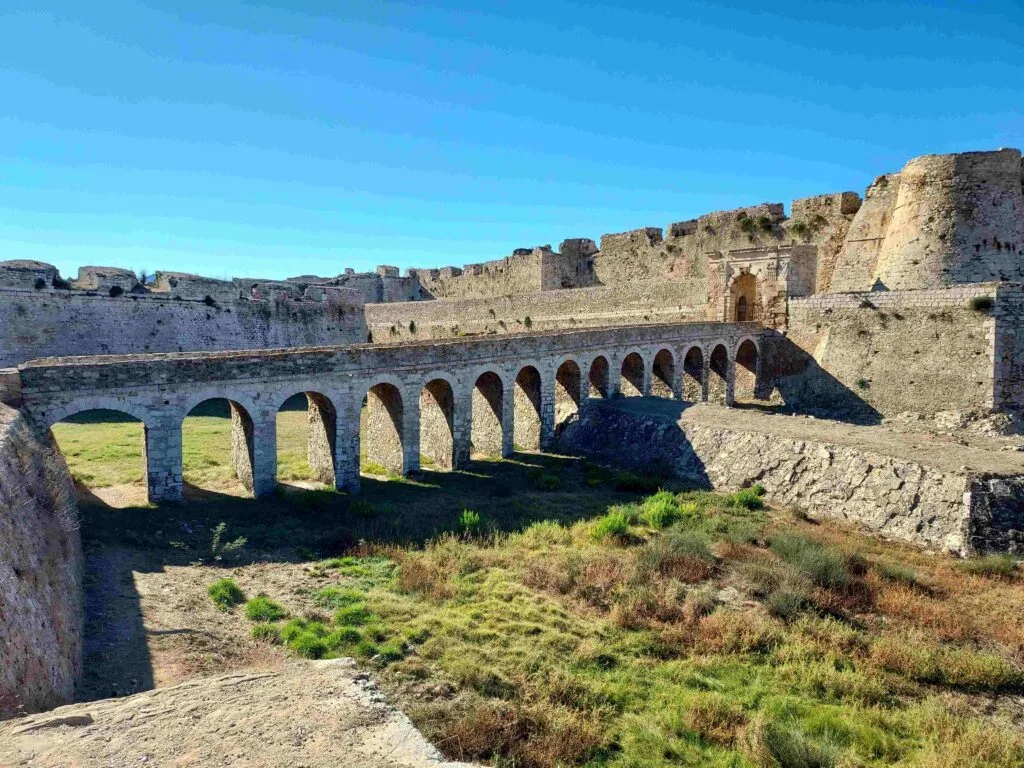
I also loved this image below: a small, octagonal tower on an islet on the south side of the castle, connected by a narrow walkway. It served as a prison and watchtower.
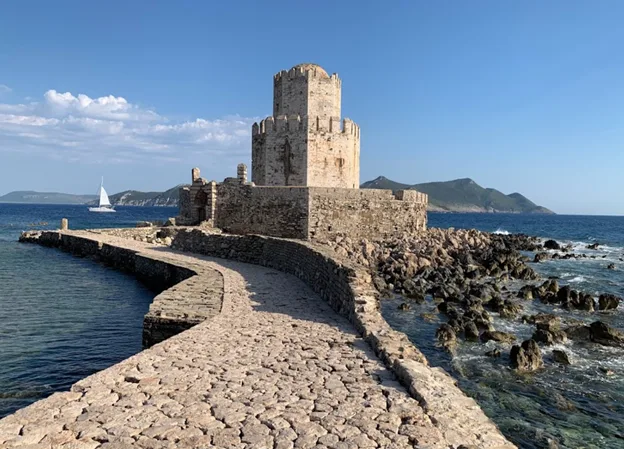
Next to this islet were fishing boats floating in crystal clear water.
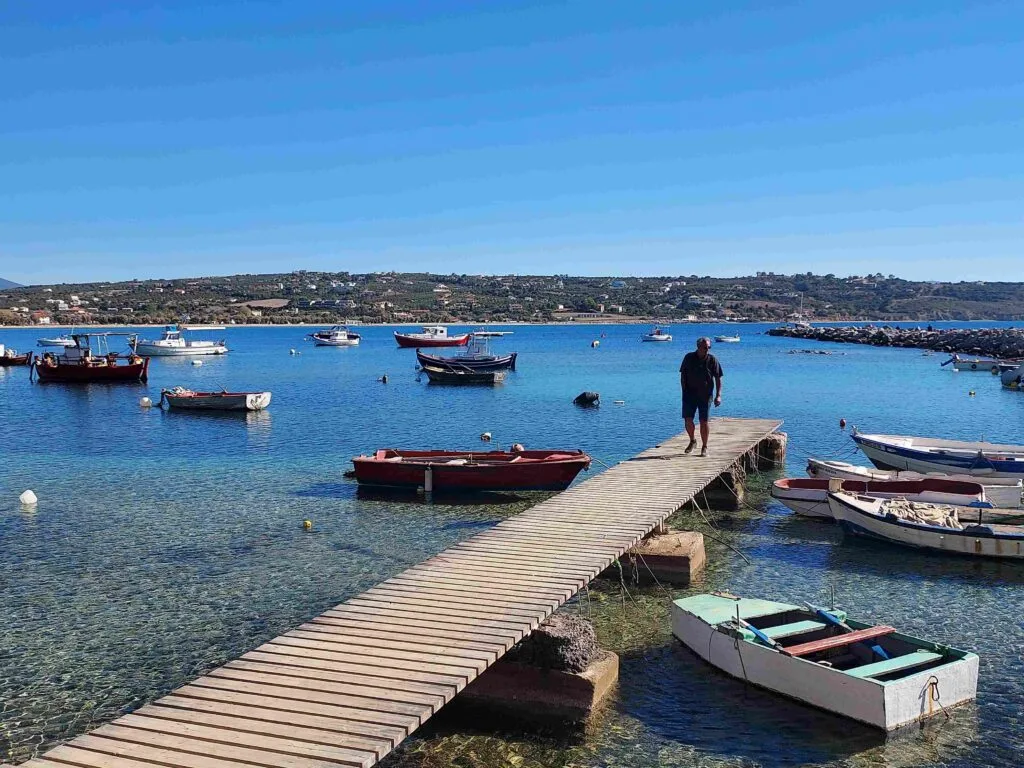
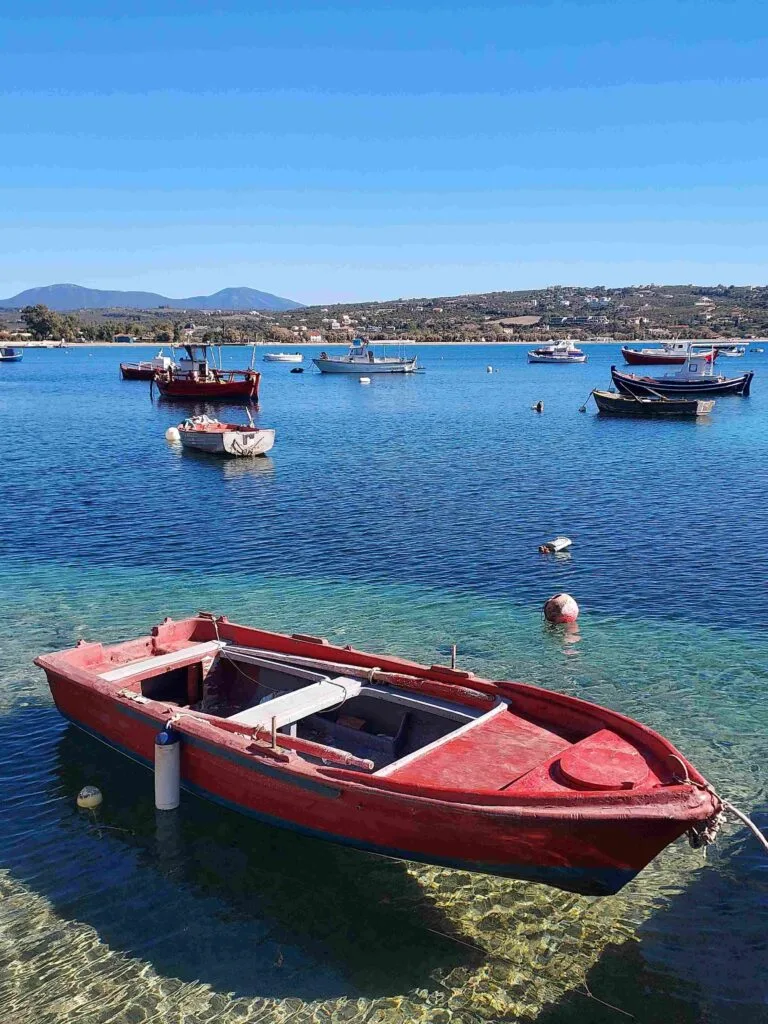
Castle of Koroni
Back in the port of Pylos we continued with the catamaran and ended up in a bay of the place. Koroni. From the bay of Koroni where we were, we saw another large castle. Also built by the Venetians.
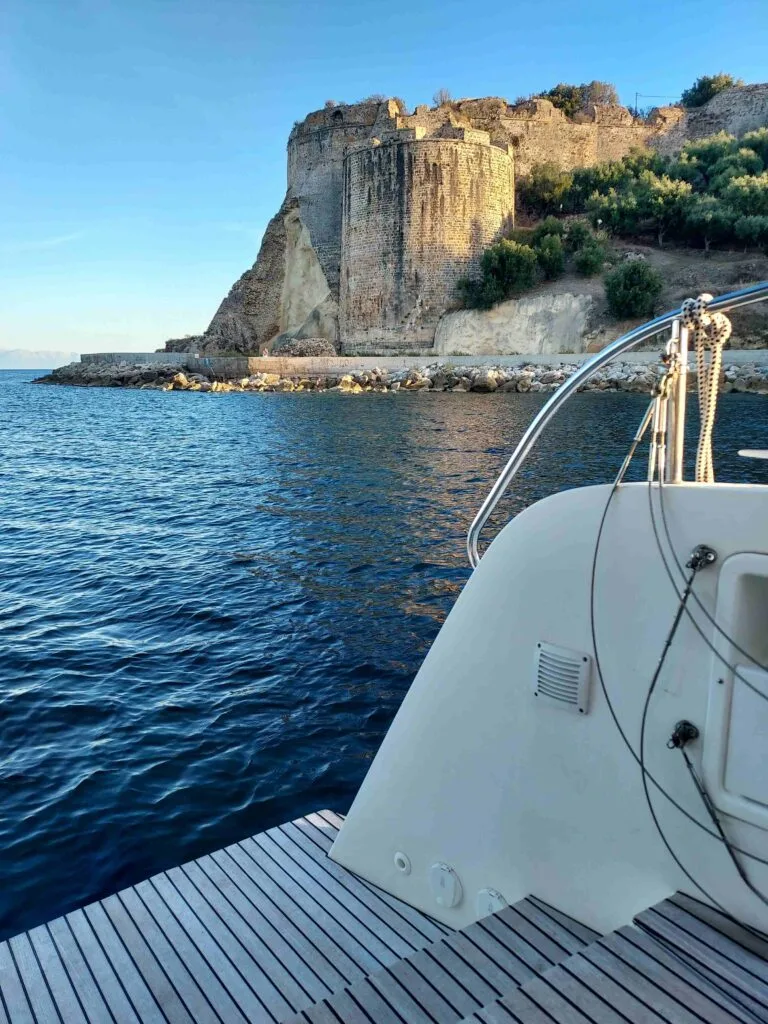
We read that Methoni and Koroni were considered “twin fortresses” by the Venetian navy and were crucial for the trade routes with the East. Koroni (or ‘Corone’ as the Venetians called it)was taken by the Ottomans in 1500, they strengthened the bastions and expanded the castle.
We thought it was such a beautiful image here, It covers 62 acres on a low peninsula. We let the drone from the boat go up in the middle of the bay and made this video:
And when you have a bird’s eye view of your boat, you suddenly see what beautiful water you are actually in! Beautifully clear and turquoise in color.
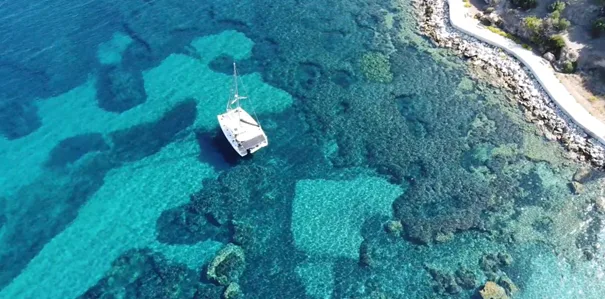
Refugee boat in Kalamata
After a day and night in nature, we decided to visit a harbor again. Kalamata is one of the largest town in the south of the Peloponnese. We registered our boat for 1 day in the port at the Coast Guard office.

This wintertime prices are very friendly. There is not always power and water, but you have a sheltered place and it’s more easy to do sightseeing and shopping. We had to wait a while for them to make the invoice, so Gilles started to read the Greec newspaper (or better: pretends to do so 😉).
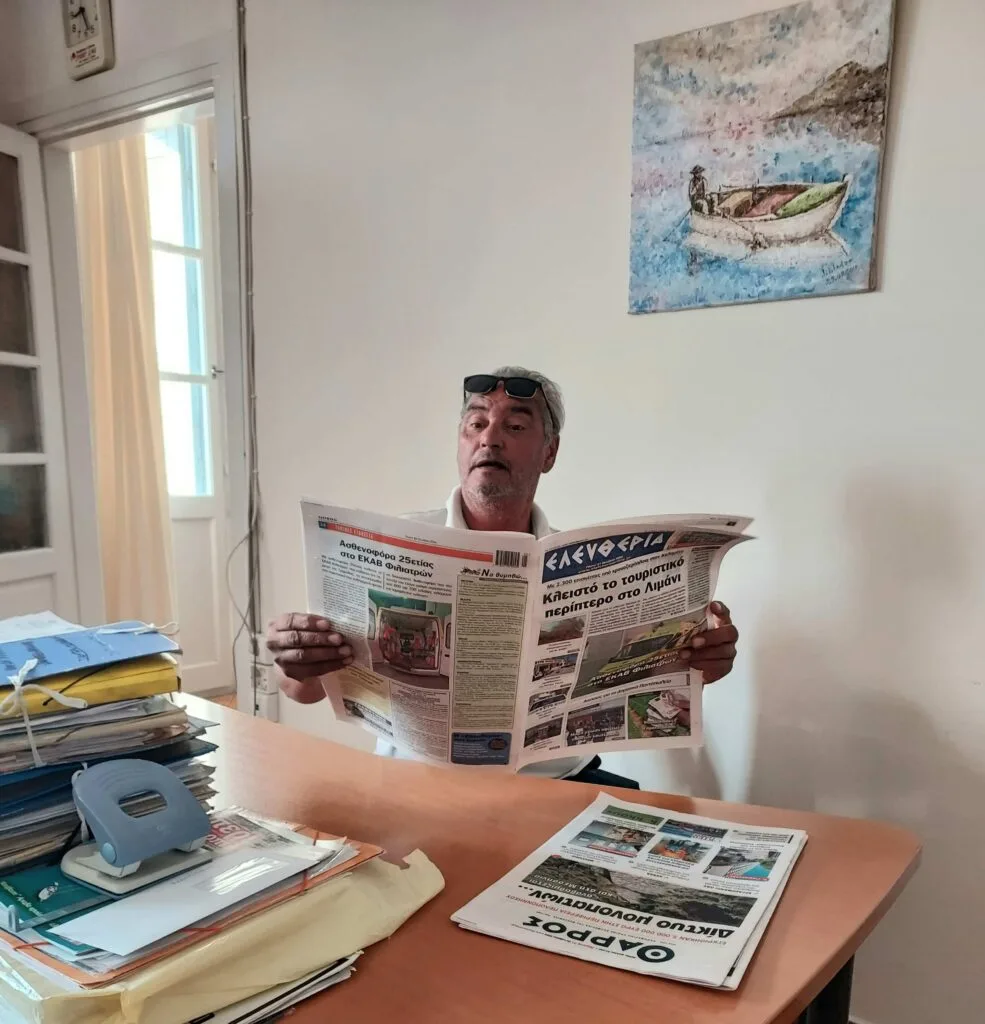
When we looked outside from the harbormaster’s office which was located at the second floor, so had a good view on the harbor, we now noticed close to us a boat with torn sails. We had seen that before in the south of Italy…
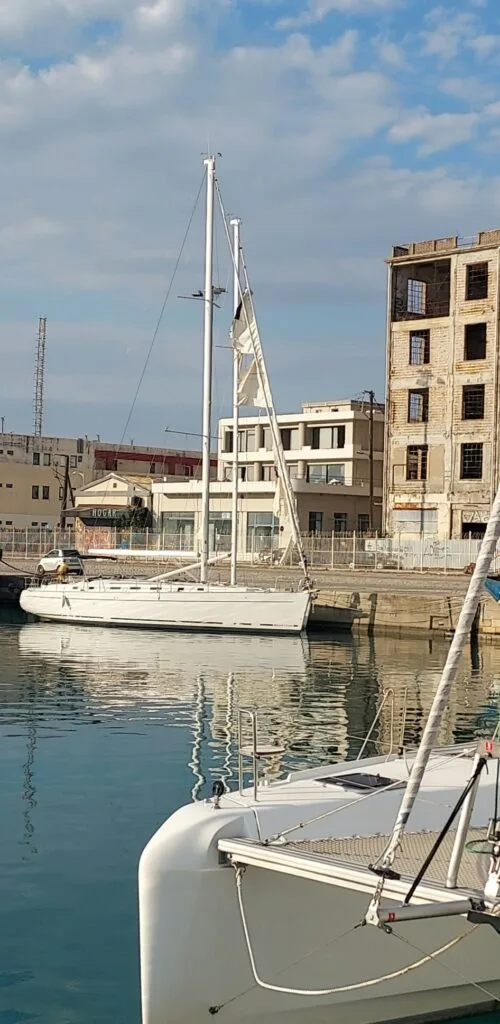
‘Yes, that’s a refugee boat’. The harbour master nods as she looks together with us from the window to the harbor. We have learned from sailing in the south of Italy, that when you see a sailboat completely stripped inside, no more equipment, and with torn sails: these are the boats on which refugees try to find their way from the sea to the European mainland.
They are put on these old boats in the middle of the sea in groups of 20 people and if they manage to get the boat to the mainland, they try to find their way to Northern Europe. What remains is a ship with a few items of clothing, such as a scarf or a shoe. It’s really sad to see and
As of August 2024, 28,352 refugees have arrived in Greece by boat. The majority come from Syria (36%), Afghanistan (25%), Egypt (12%), Eritrea (4%) and Palestine (4%). Of those who arrived by sea, 16% were women, 26% were children and 58% were men.
How to get diesel for our catamaran?
And after being impressed by seeing a refugee boat, your own ‘problems’ pale into insignificance. I always call them ‘first world problems’. Like when our diesel was almost empty and we really had to fill up. In the town of Pylos we had asked the harbour master: €1.80 he said. We thought that was too much. For 600 litres of diesel it makes quite a difference whether you pay €1.65 (which we saw much more often in the harbours) or €1.80. So we went to look in Methoni or Kalamata. Methoni did not seem to sell diesel and in Kalamata we saw 2 petrol stations near the harbour. Great. Both closed. Unfortunately. This did not go well, because we do not get many larger places than Kalamata and certainly in the winter it is apparently closed.
Gilles saw a petrol station for cars on the other side of the harbour, along the road with cars. Still, we had to ask. They had a small tanker that they could ask to come by the next day. Especially for us. I asked how much this diesel would cost per liter, because that sounds quite VIP! It was € 1.50 per liter. Well, of course we were happy to do that!
And at 10:00 the small tanker arrived the next day with a friendly chauffeur. It attracted some attention from other boats that were also moored along the quay, so this little sailing girl came to have a look. But we were very happy and it was a bit of a gamble, a very last minute solution. But hey, you have to take that chance sometimes!
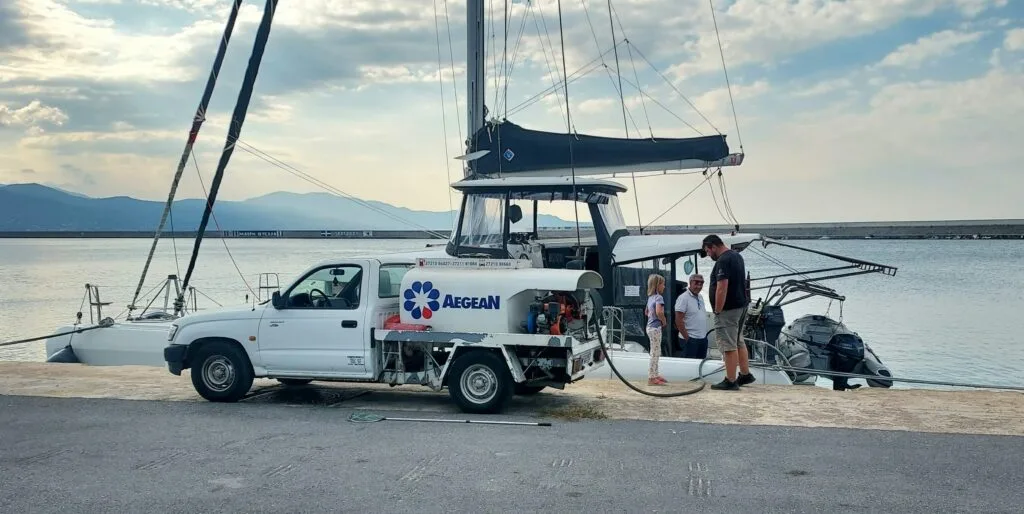
Caves of Diros: boat trip through an underground lake
And as it often goes, the best tips for the best things to visit come from locals and other sailors. And in this case the little sailor girl, she advised us to visit the Caves of Diros which were on our way south.
I had already read about it, but it didn’t seem super special to me, according to her it did and her parents who came walking also called it a real recommendation, so we sailed there.
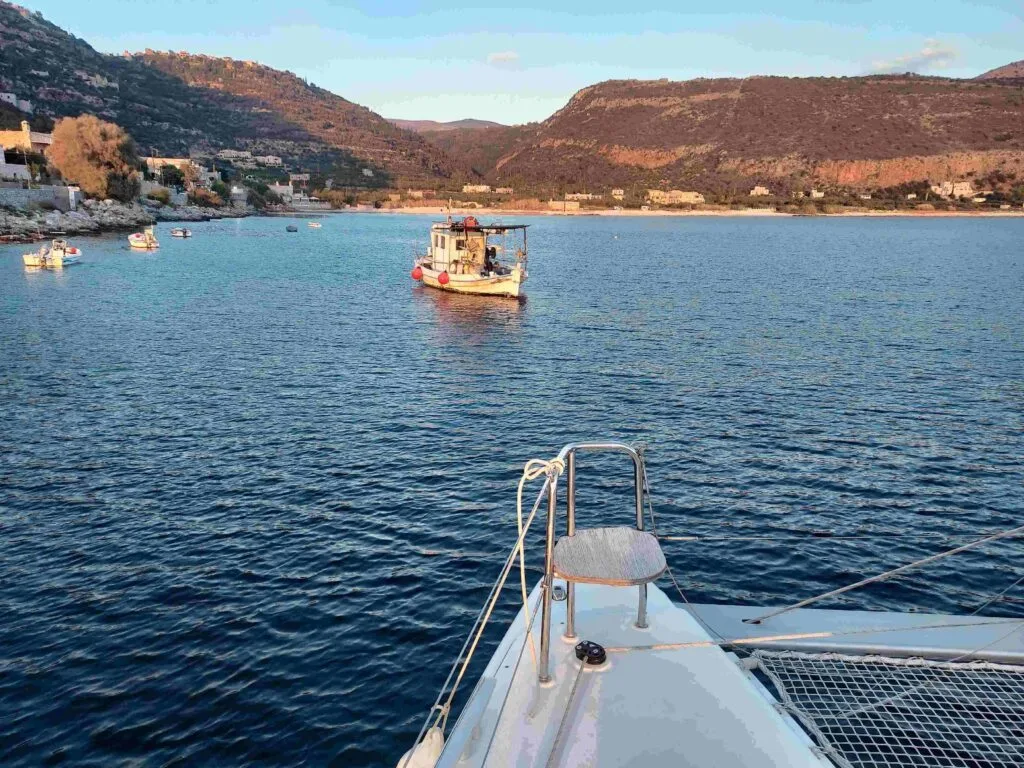
It was a beautiful day when we moored our boat at a natural quay. Then we took the dinghy to the bay at the Caves of Diros. The sun reflected on the water, which was so crystal clear that we could see the marine life swimming below us.
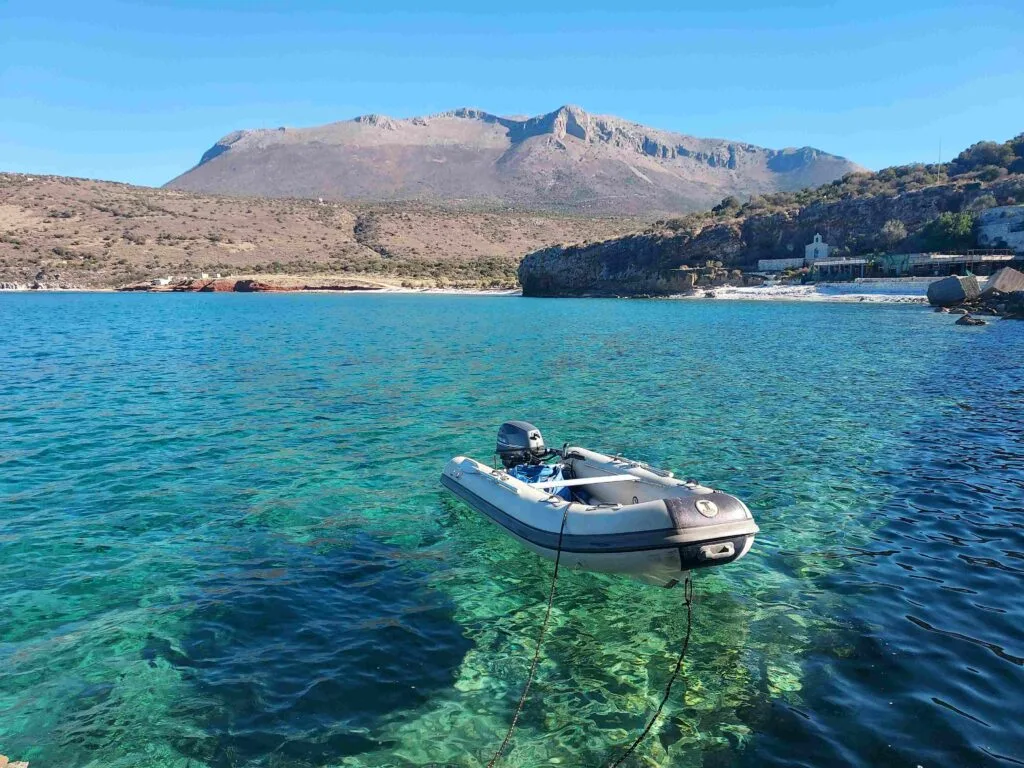
The Caves of Diros are considered to be one of the most beautiful cave systems in the world. These hidden wonders lie deep in the limestone hills of Mani and stretch for about 15 kilometers. The caves are millions of years old and are filled with breathtaking stalactites and stalagmites, formed by centuries of dripping water.
Upon arrival, we were welcomed by a guide, who took us on a boat trip through the underground lakes of the caves. The silence was impressive; the only sound we heard was the soft splash of the oar of the rowing boat, and the echo of our voices. All around us were spectacular rock formations, mystically brought to life by soft lighting.
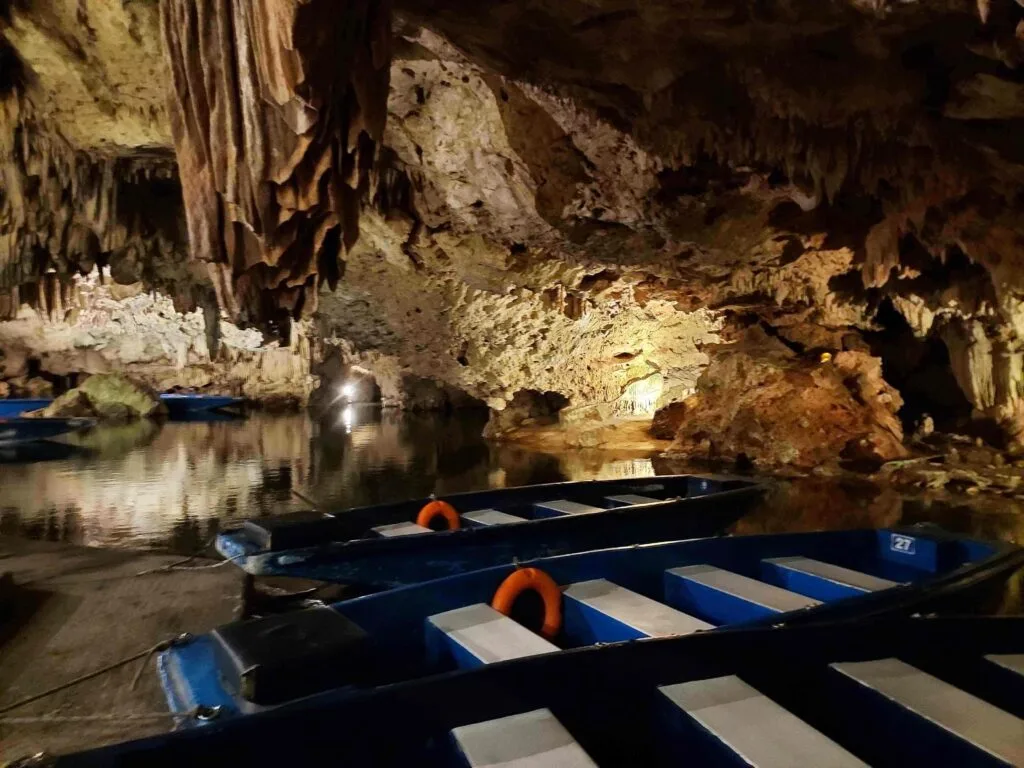
What makes these caves so special is that the rowing boat takes you through the narrow passages, and sometimes even have to duck for the ceilings or walls that come very close. After every bend you are surprised by all the colors and shapes. I filmed part of the boattrip in the underground lake:
The caves were already inhabited 6,000 years ago, archaeologists have found ancient artefacts here, such as ceramics and tools. The water in the caves is a mix of fresh and salt water and remains at a constant temperature of 14°C all year round. The last part of the caves, you had to walk your way back up.
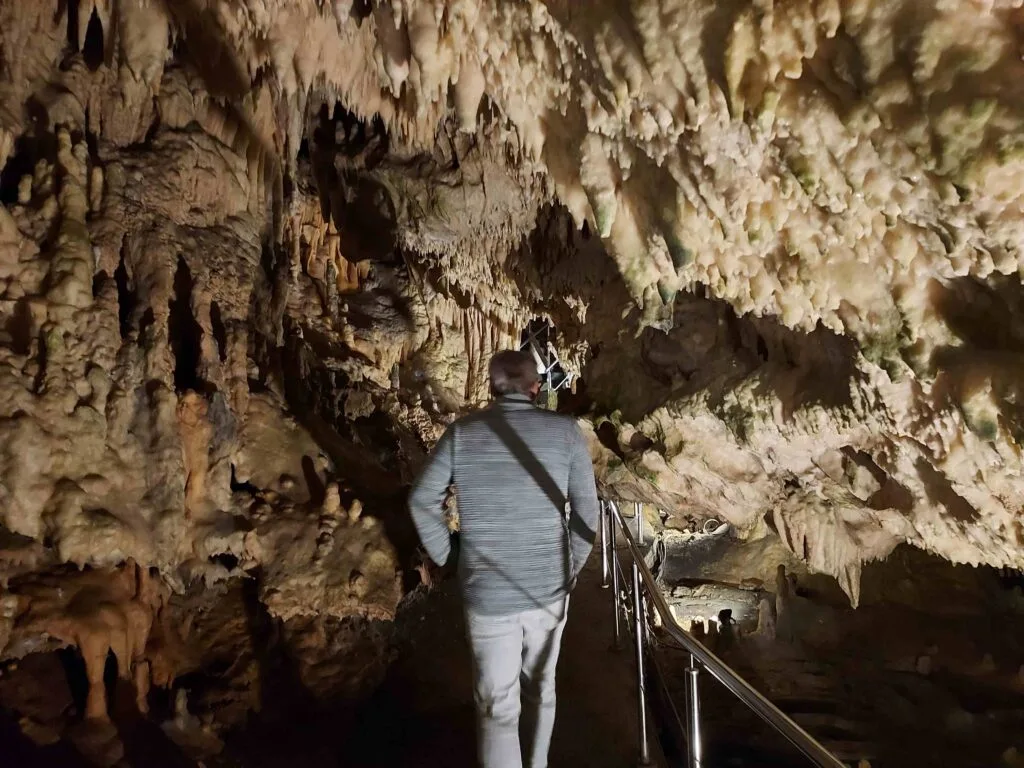
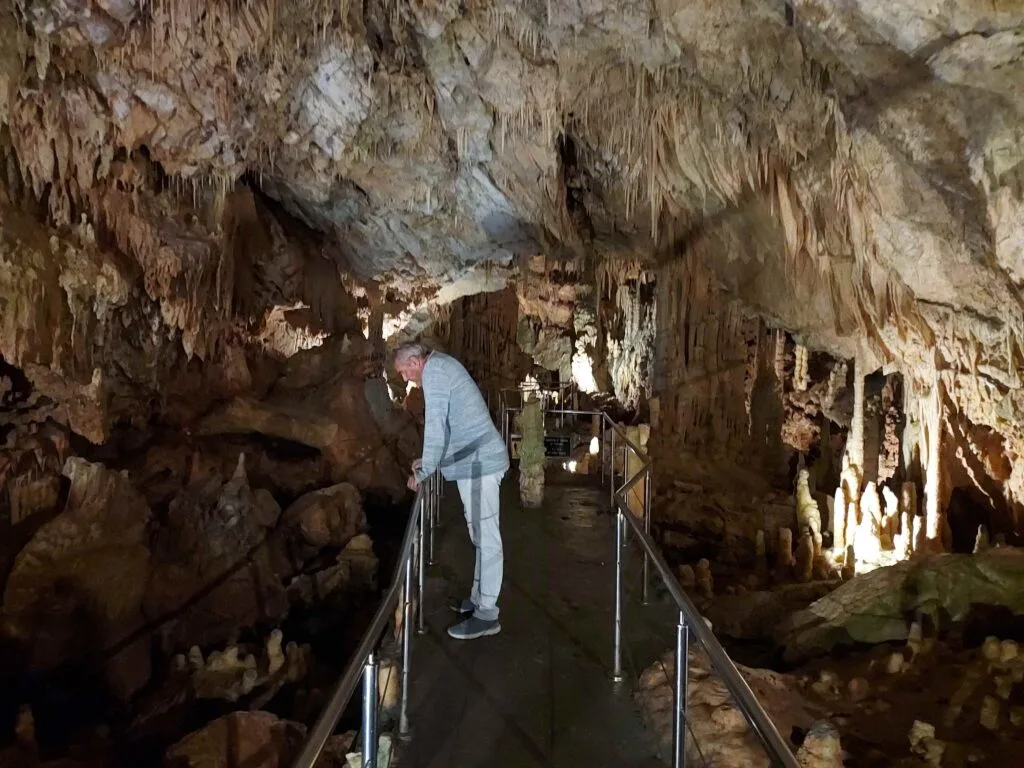
Most Southeastern tip of Peloponnese
After the caves, we sailed to the last place we would see at Peloponnese, before we would make the crossing to the island below this peninsula. As you can see below in the pictures, this part was very remote, almost no houses, but lovely green hills and clear water.
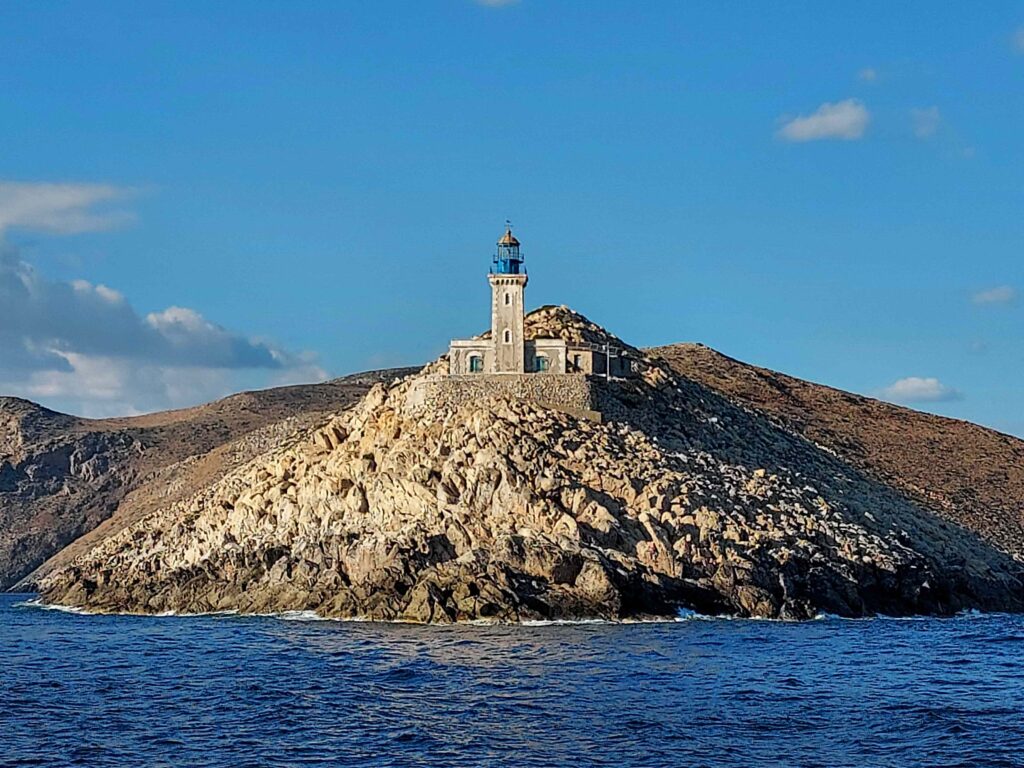

Time to prepare to visit Kithera, the island between Peleponnese and Kreta, our stop before we would visit Kreta!
